Napoli had a good start in the 2019/20 Champions League campaign. In the first game, they secured a victory on European Champions, Liverpool thanks to Dries Mertens’ and Fernando Llorente’s goal. They travelled to Belgium and played against Genk. Genk now positioned at the 6th in the league, and they were crushed by Salzburg with a 2-6 defeat. Napoli aimed to take all three points and continue becoming the first in the group.
In this tactical analysis, we are going to show you the tactical battle between Genk and Napoli, and how the tactics resulted in a draw.
Line-ups
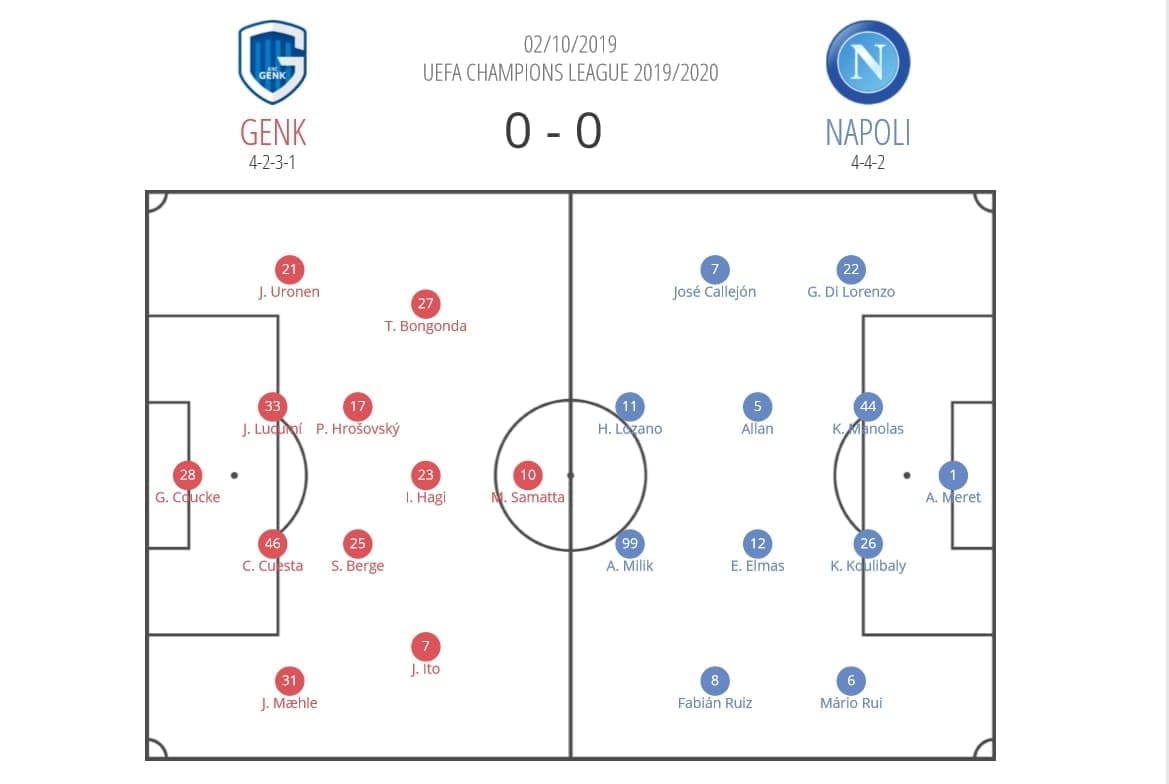
Felice Mazzu’s Genk started in a 4-2-3-1 formation. Colombia centre back Jhon Lucimí partnered another Colombian Carlos Cuesta in defence. Japanese Junya Ito started on the right flank; Theo Bongonda started on the left; Mbwana Samatta was the lone striker.
Carlo Ancelotti instructed his team to play in a 4-4-2 formation. Both goal scorers in the Liverpool game were benched. The squad was rotated, Mário Rui started instead of Faouzi Ghoulam. Despite the match ban in Serie A, Kalidou Koulibaly returned to the squad. Piotr Zieliński was on the bench and Fabián Ruiz took his position. It was Hirving Lozano who partnered with Arkadiusz Milik.
The build-up of Napoli
Napoli built-up in a safe manner. They emphasized on the numerical superiority and they committed four players in this phase. Two centre backs, the right-back Giovanni Di Lorenzo and one of the central midfielders were involved. With their structure, they could form two layers to break the press from Genk’s striker Samatta.
As the below image is shown in this analysis, Napoli built-up with four players. The positionings of Konstantinos Manolas, Di Lorenzo, Koulibaly and Eljif Elmas formed a box. Meanwhile, Brazil central midfielder Allan took away the attacking midfielder of Genk. It created a situation that allowed Elmas to turn freely after Napoli surpassed Samatta.
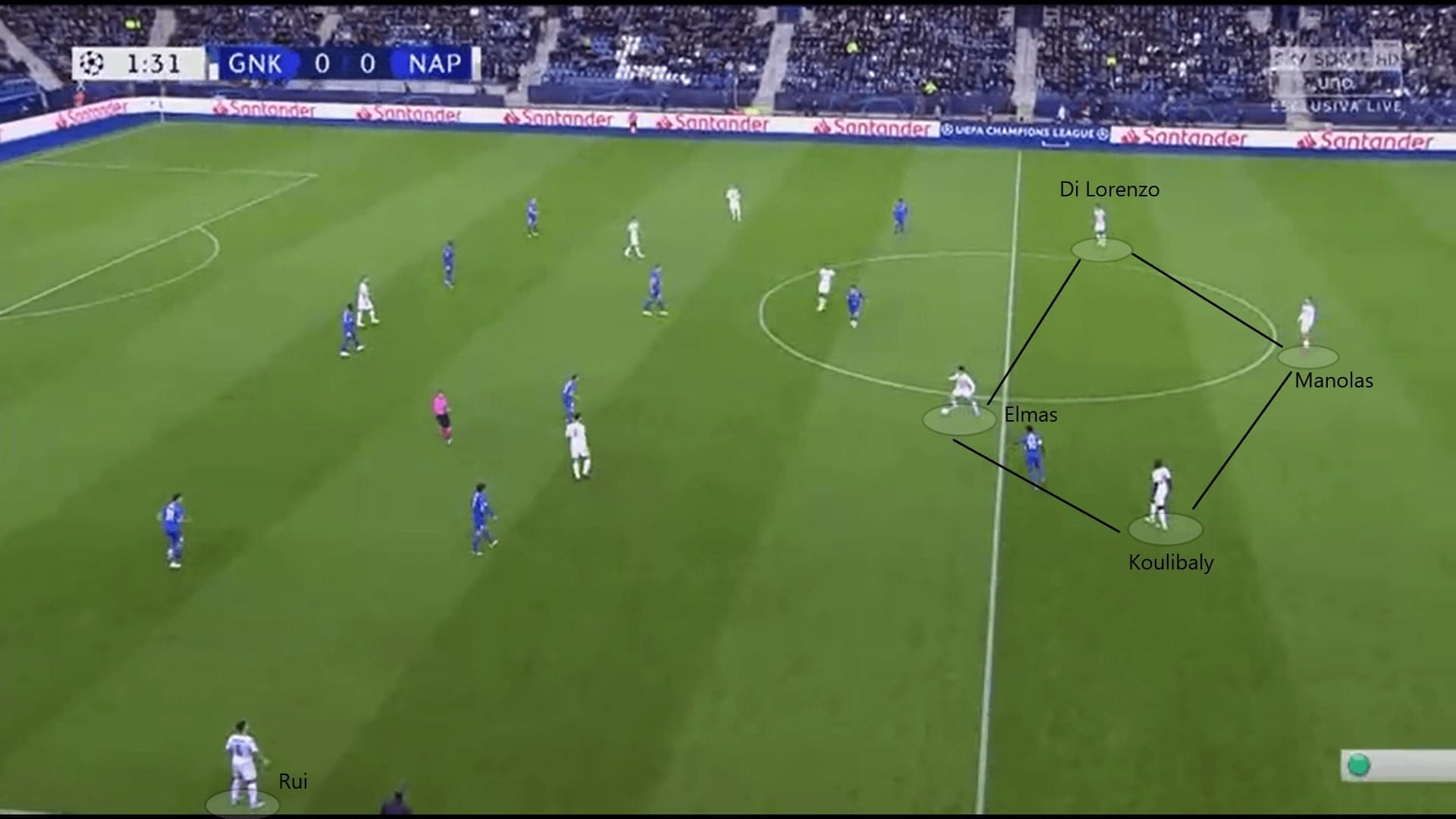
Genk’s high pressing
However, the build-up of Napoli did not work every time, especially when Genk committed numbers forward to press. In this game, especially the first half, Genk pressed high and intensely with a man-marking approach on the ball-side. They tried to eliminate the passing options of Napoli and win the ball back if there are hesitations from Napoli’s players.
When Genk decided to press high, they did well to press in a unit. Just as the below scene, which the double pivots of Napoli dropped together with José Callejón. Genk responded well and they managed to mark all players on the ball-side. They delayed Napoli’s attack with a foul.
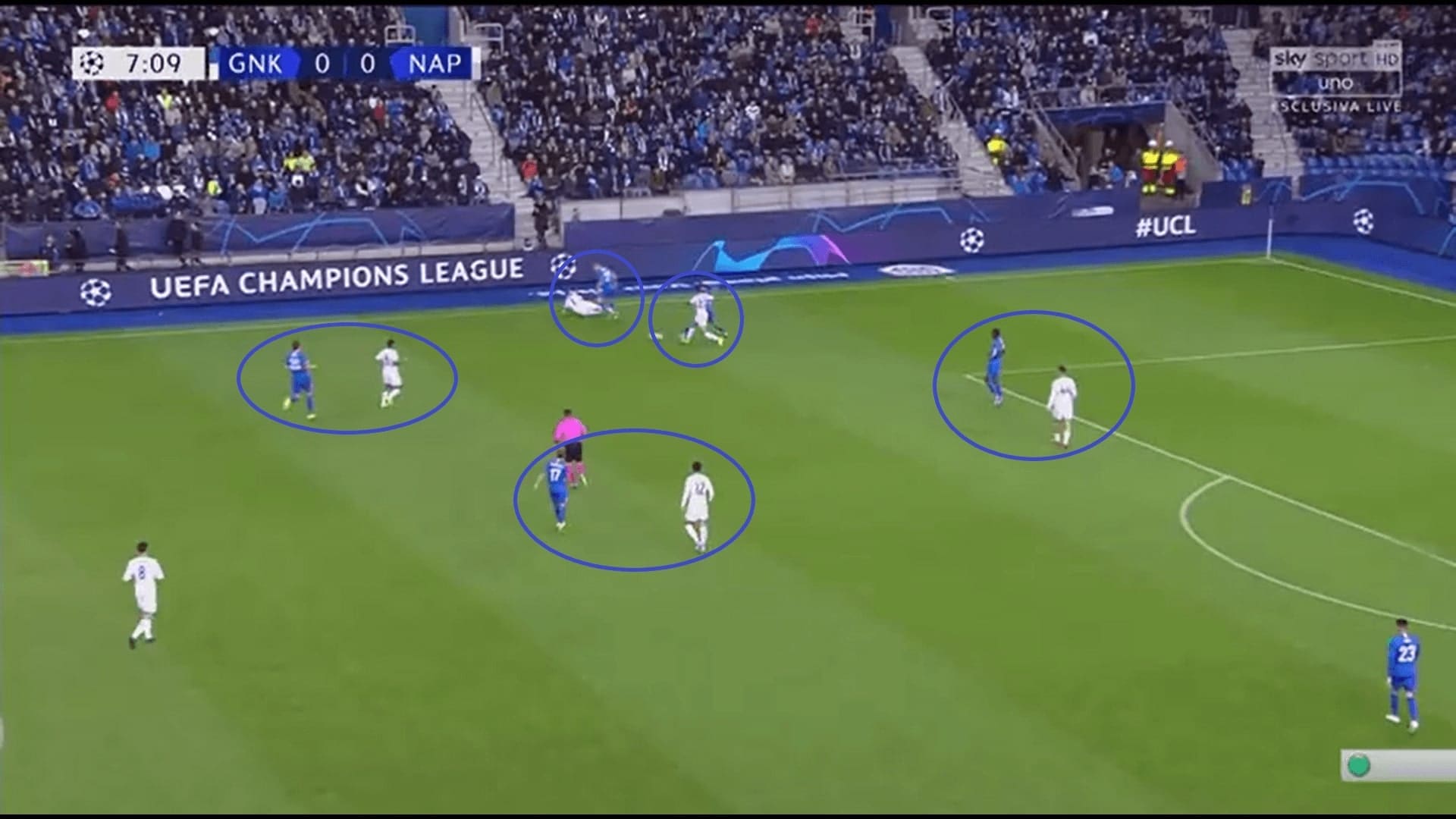
This was a successful scene from Genk’s high press. Again, Napoli tried to build-up from the back. Manolas passed the ball to Di Lorenzo. At this moment, all passing options were marked by a blue shirt. The Italian right-back could not pass shortly. Patrik Hrošovský positioned himself cleverly behind his teammates, which avoided Ruiz as a passing option between the lines.
Di Lorenzo did not have an option, he kicked the to the right flank, which allowed Genk to win the ball in Napoli’s half. Genk retreated and formed a 4-4-1-1 block in the midfield if they did not press. However, pressing still mattered in Genk’s defence. They relied on the anticipations of defenders and covering of players to prevent Napoli from creating their chances.
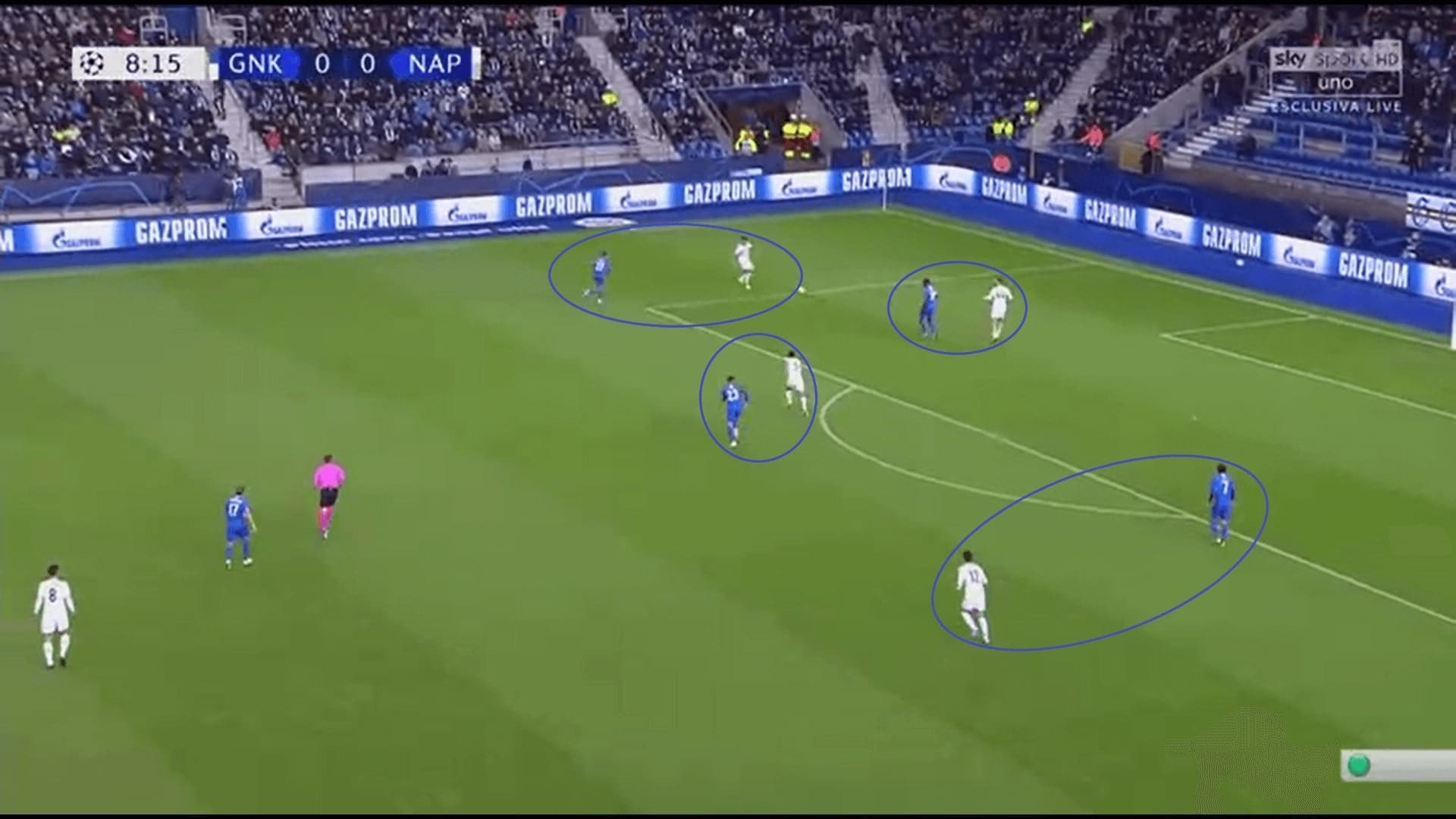
Napoli on the left
Despite constraint by the press from Genk, Napoli were able to progress the ball after Genk fell to a 4-4-1-1 block. This was the situation that they spread the ball wide and moved the ball to the final third. The tactics they used on both flanks were different. On the left, with Rui to provide the width, and he attacked with Elmas and Ruiz.
In the first example, we saw Rui, Ruiz and Elmas formed a passing triangle. The Portuguese left-back stayed wide and allowed Ruiz to position himself in the half-spaces. This drew the Genk right-back Joakim Mæhle out and Ruiz would run to space generated behind him. Of course, Napoli sometimes failed since the early press by Genk defenders forced the ball back, just like this time.
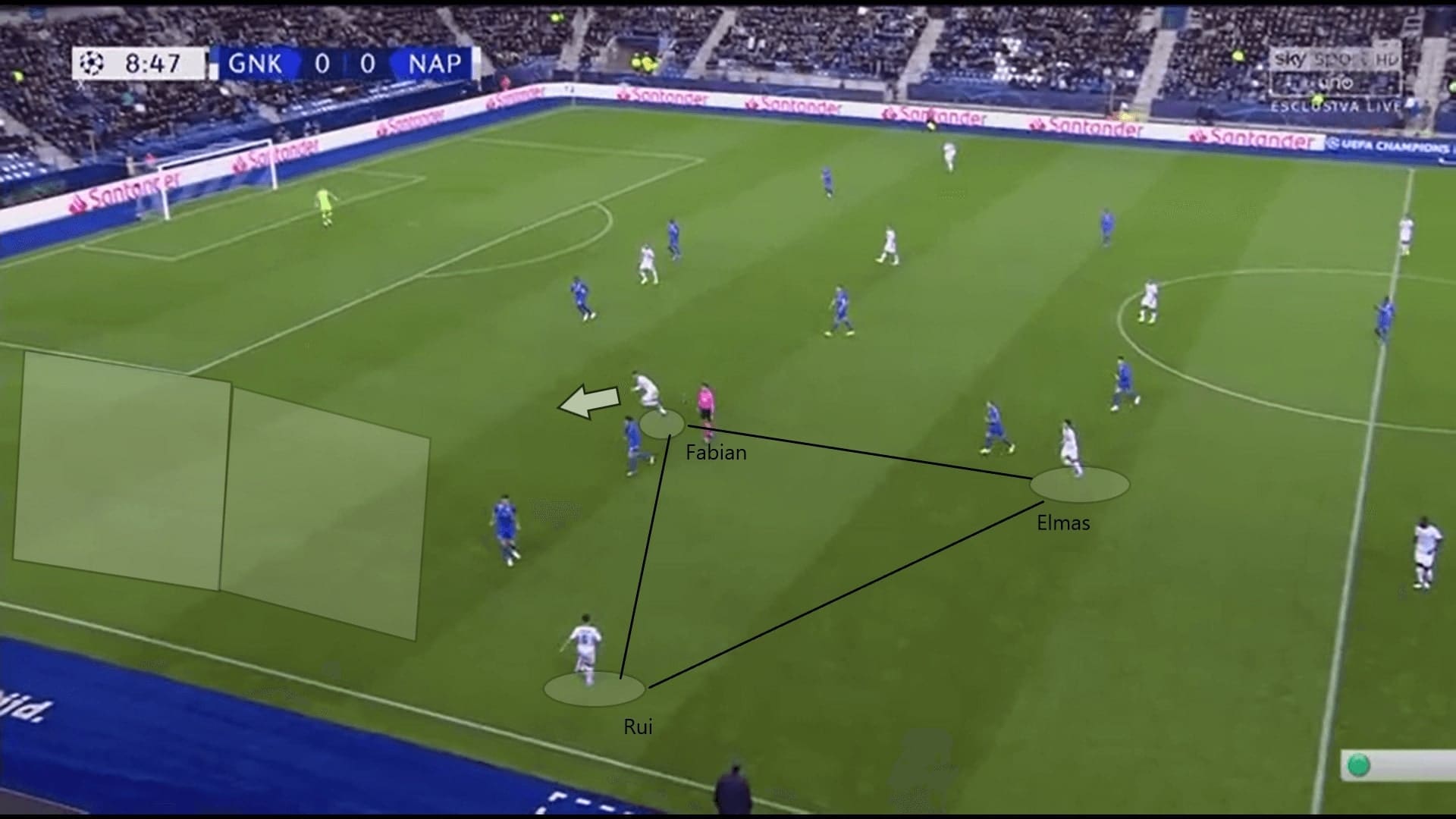
With Rui’s occupying the left flank, it created a benefit for Ruiz. The 23-year-old Spanish could get rid of his marker since Genk players usually focused on Rui. Moreover, Ruiz could make blindside runs behind the midfielder, which exploited space behind Mæhle.
This allowed Napoli to entered the final-third in a very fine condition. Ruiz’s movement forced Cuesta out, and it created a one v one situation for Milik against Lucimí in the box. The only task left for Ruiz was to pick the Polish, and Cuesta managed to block the cross. Unfortunately, after the injury of Rui, Napoli had to attack in another way.
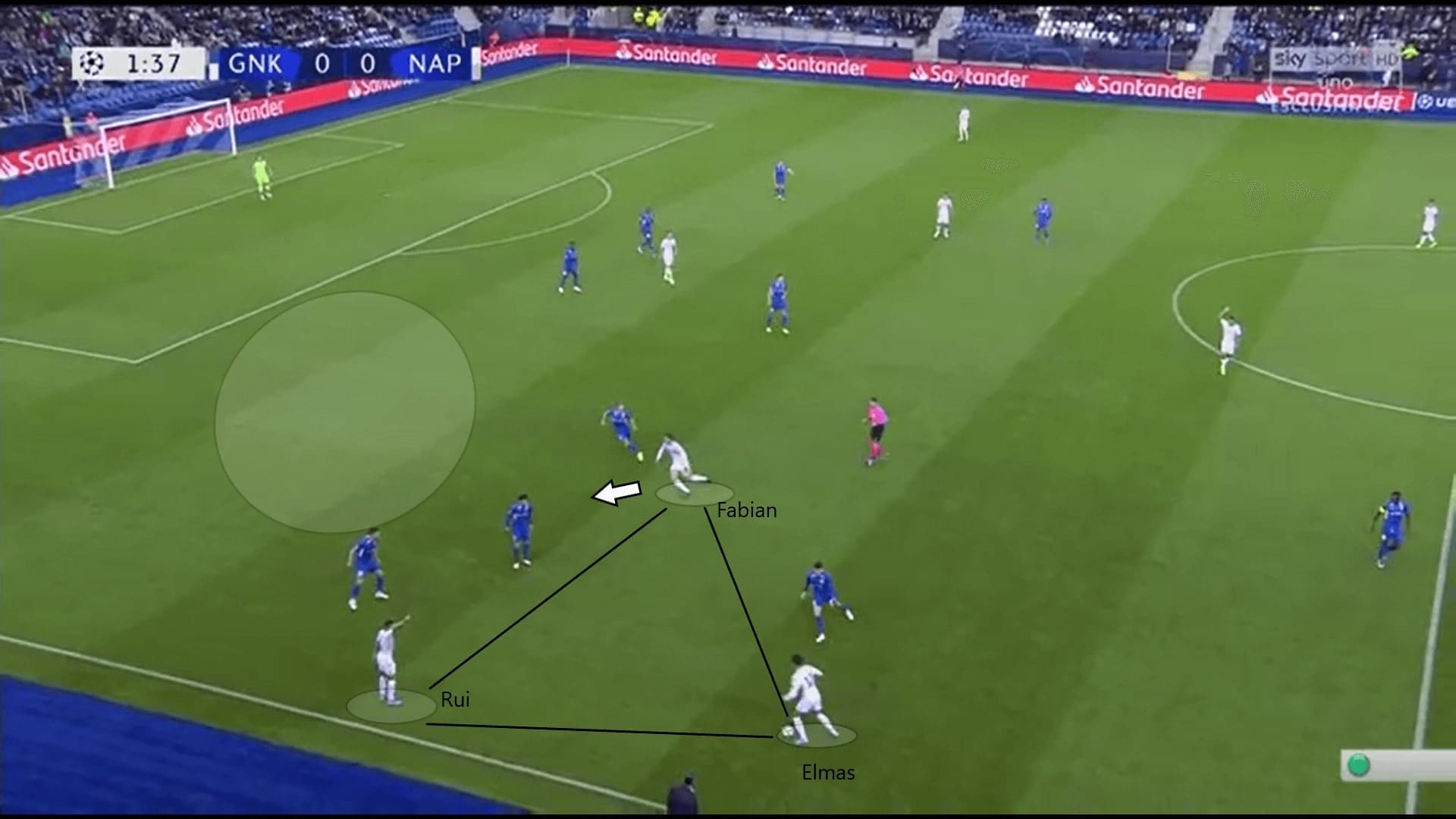
Napoli on the right
The situation on the right was different from the left. It was because their right central midfielder, Allan, stayed deeper to protect the midfield more. Lozano usually dropped between the lines, to the right half-spaces. Callejón was the man to provide width as Di Lorenzo stayed deep to process the build-up.
The below scene, which Lozano received the ball from Allan, drew the attention of Genk left-back Jere Uronen and Hrošovský. This Callejón stayed free on the right flank. As a result, the Spanish winger could cross in a better condition, and his cross nearly opened the scoring. The cross from Callejón was met by Milik, then hit the bar.
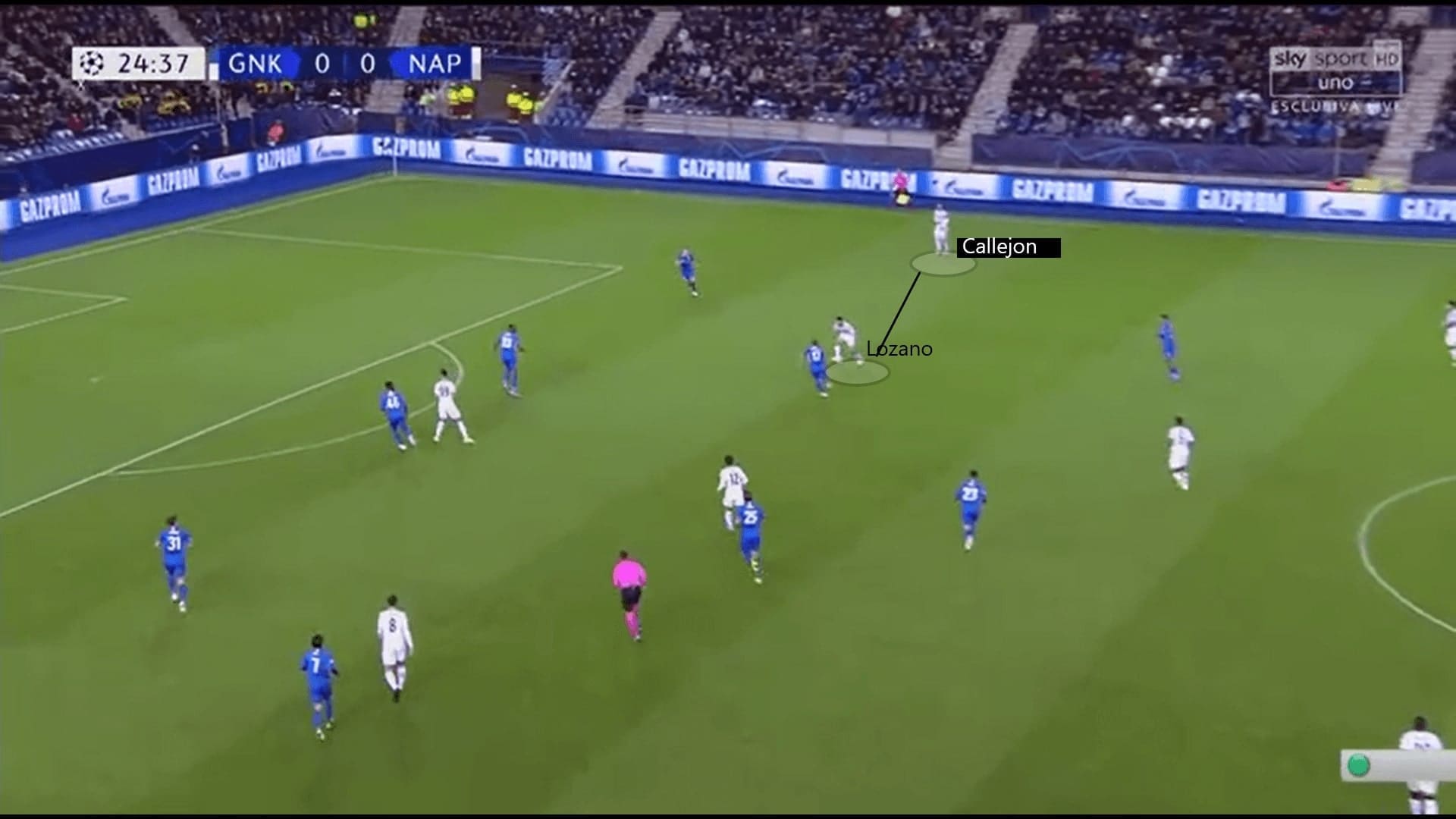
Sometimes this type of attack failed due to the following reasons. First, it’s the close body shape of Lozano when he dropped. The Mexican was forced back to goal, and not every time he could open his body to find Callejón. Also, the anticipations of Genk players did not allow Lozano to turn or even won the ball back. Just as the below example, Allan passed the ball to Lozano, Lucimí anticipated the pass, stepped out early and won the ball.
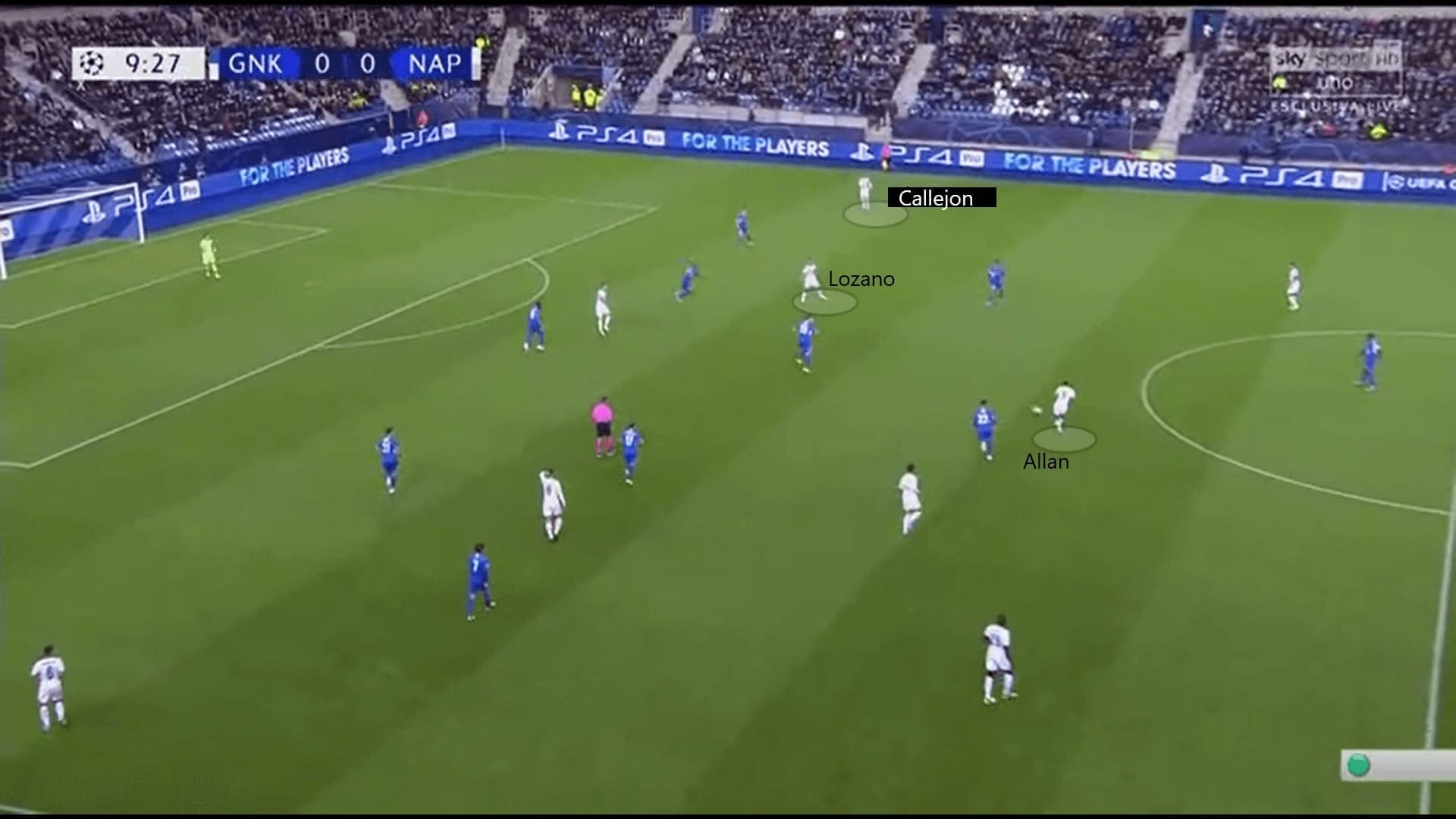
Napoli’s defend
Napoli pressed high on some occasions. Before they form the defensive block in their own half, they still tried to commit numbers forward to defend. They allowed their strikers, a full-back and a central midfielder on the ball-side, and the wingers to press. The approach was like Genk’s, as they also tried to mark the short options.
The below scene was an example, Napoli pressed high in a Genk’s throw-in. All the short passing options of Cuesta were unavailable as Rui and Elmas stepped out to cooperate the press. Cuesta could not switch plays as Lucimí was marked as well. The Colombian could only go long, and Manolas easily won the ball back in the aerial duel.
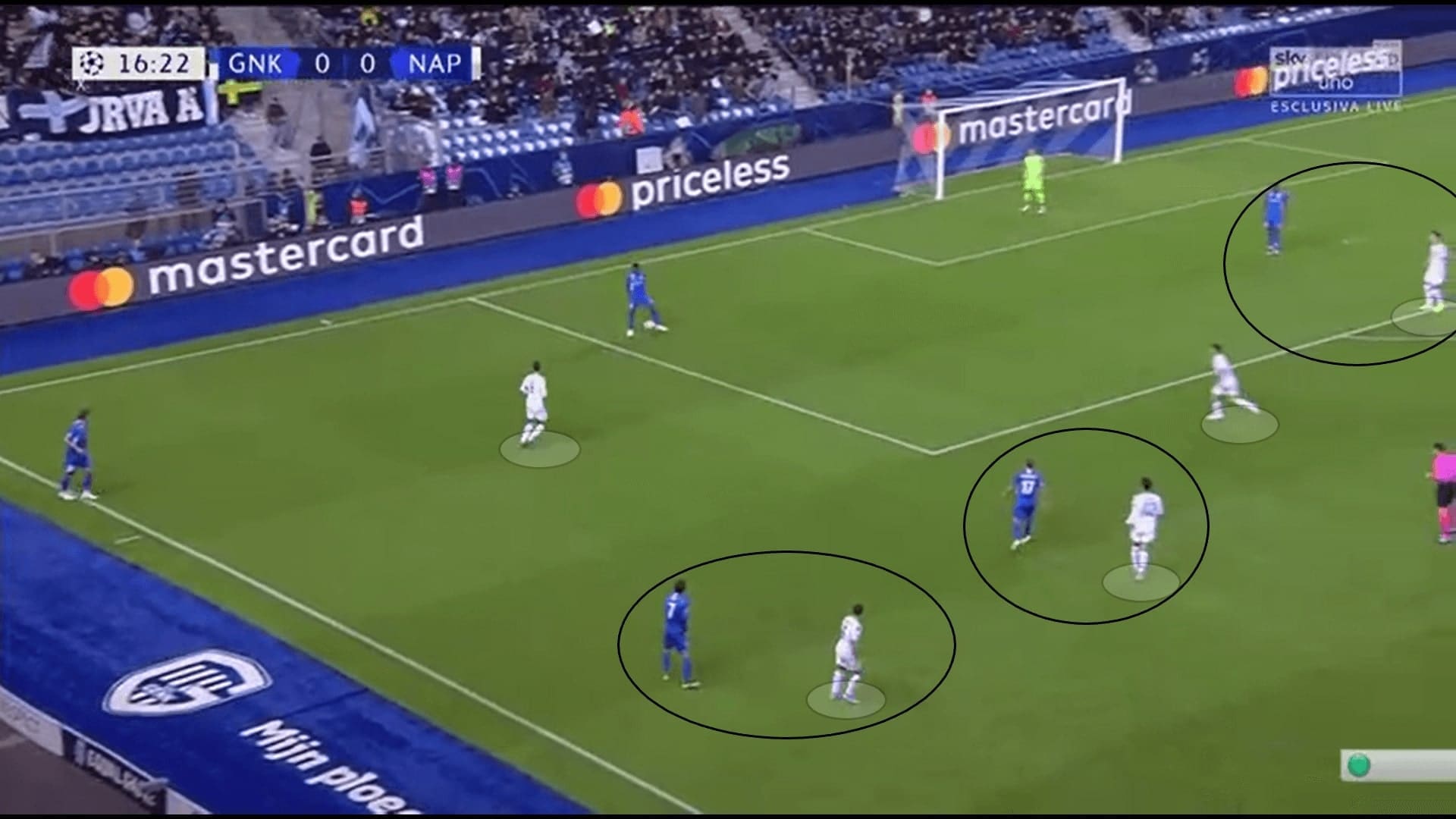
However, sometimes Genk was rewarded if they did not play long early. Since Napoli only committed one central midfielder to press, there were rooms for Genk players to play short. Without help from the Milik or Ruiz, Genk could overload the lone pressing central midfielder.
The double pivots of Genk, Hrošovský and Sander Berge, overloaded Allan as shown in the below example. Since neither Milik nor Ruiz moved closer to Allan to cooperate the press, the Genk players could go behind the Brazilian with quick a one-two. In this case, they progressed the ball forward and ended up with a cross.
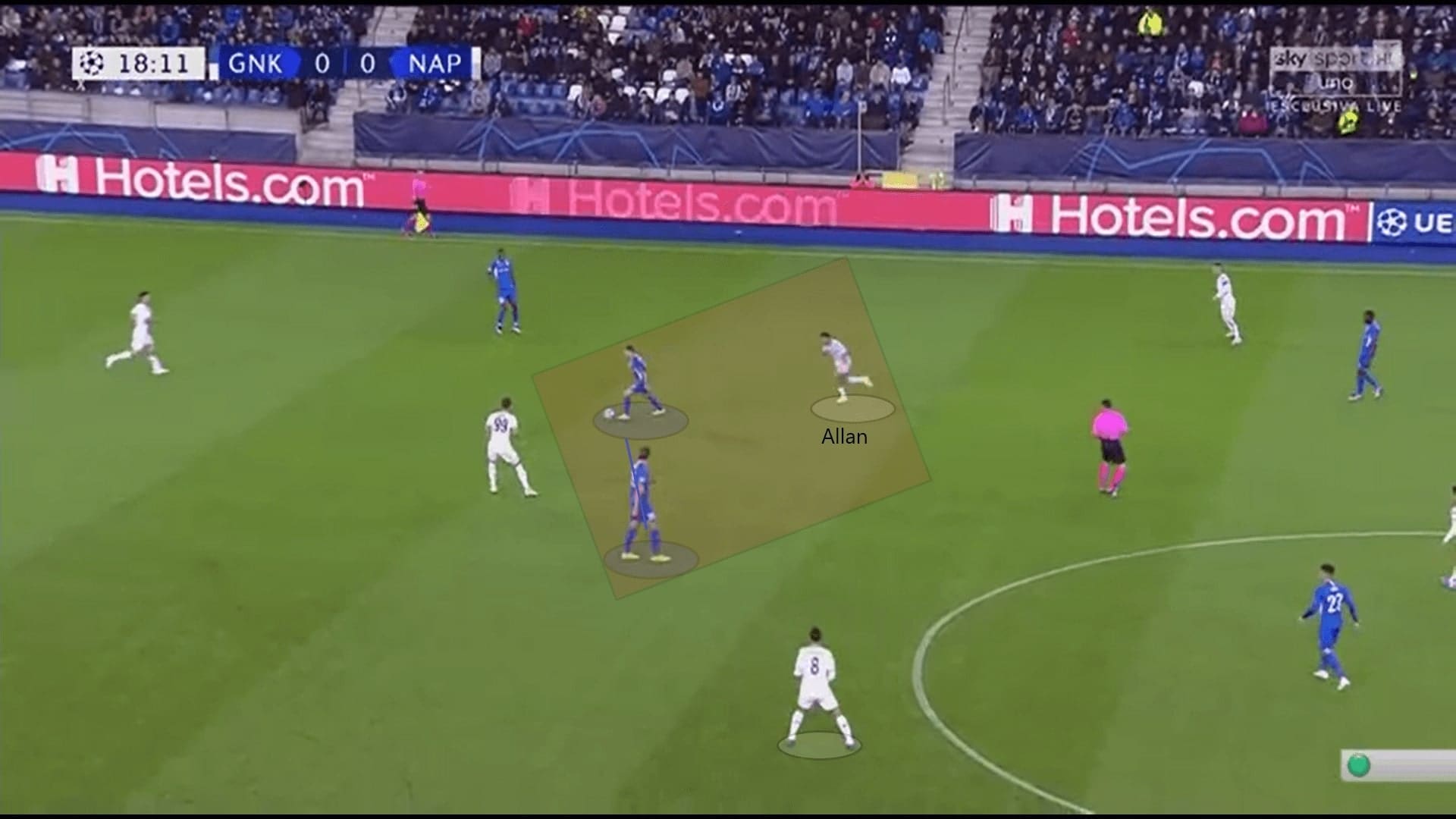
Changes by Ancelotti
Given the introduction of Kévin Malcuit and the lack of goal in the first half, the experienced Ancelotti made changes after the break. The French first replaced Rui as the left-back in the first half, but he played on the right. Lozano moved to the left wing and Ruiz positioned centrally.
Since Di Lorenzo was the left-back, Napoli now attacked with other players on the left. Lozano was a right-footed player so he could drift inside with his right foot. Fabian positioned himself higher as an attacking midfielder.
The below example illustrated. Lozano’s pass found Milik who dropped deeper. Meanwhile, Ruiz tried a blindside run behind Cuesta again. These three players formed the passing triangle and quick passes allowed Ruiz to receive the ball. The cross from Ruiz resulted in a golden chance wasted by Callejón.
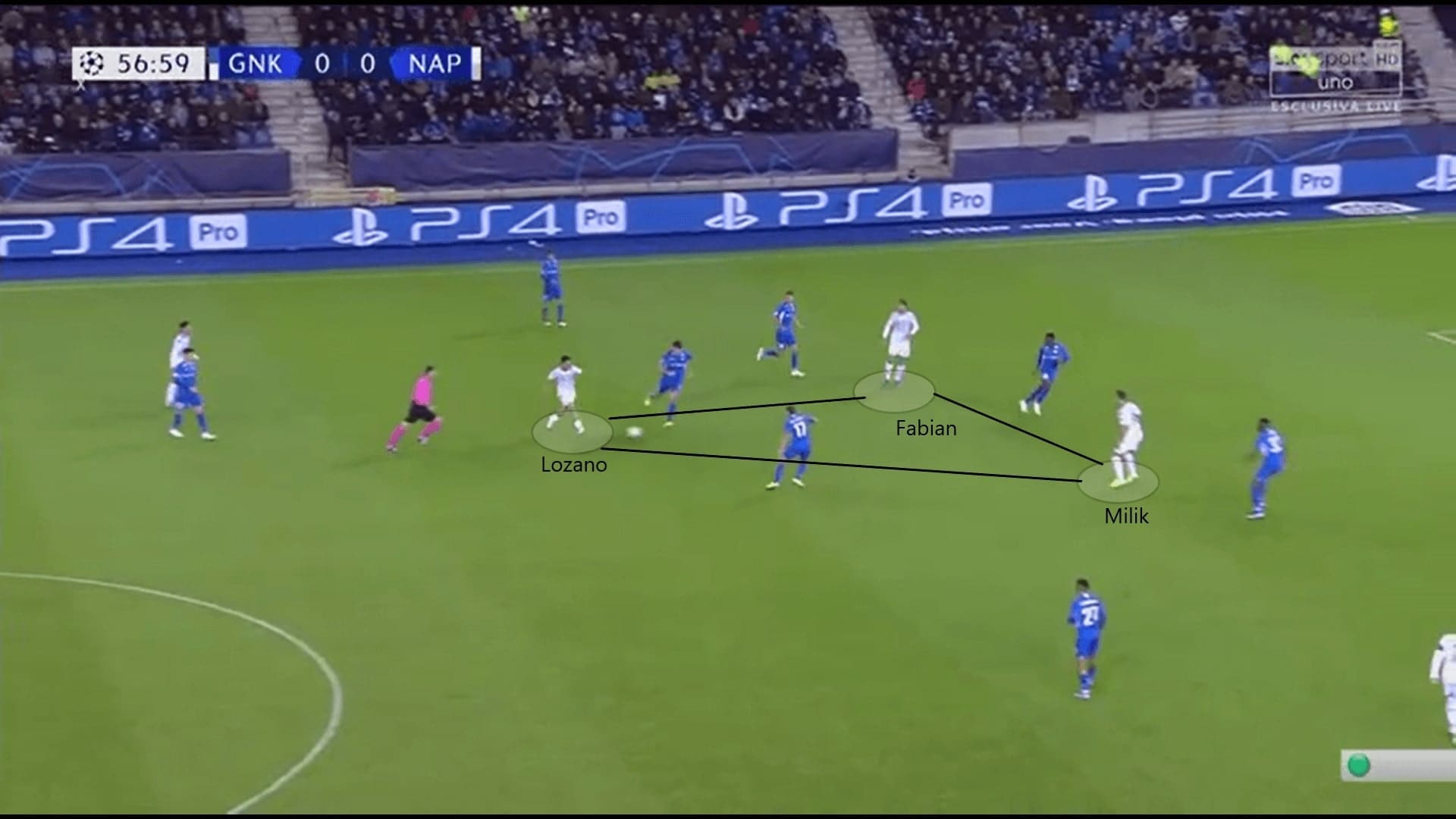
The situation was getting more interesting after the introduction of Mertens. After the Belgian replaced Elmas, he switched his position with Lozano frequently. Ruiz, Lozano and Mertens were the players staying close to each other and they attacked down the left flank, even without the supports from left-back.
In the below example, Mertens, Ruiz and Lozano were all on the left. When Lozano got the ball out wide, the 24-year-old Mexican could use his pace to beat Mæhle and cross with his left foot. The one on one situation was created thanks to the positioning of Mertens and Ruiz. These two players took away two Genk defenders, created a chance for Lozano to take on Mæhle.
In other cases, which Mertens positioned himself wide on the left, was different from what Lozano did. Mertens did not do the same with Lozano. Instead, the Belgian would make diagonal crosses from the left. Statistics reflected that there were eight crosses from Mertens in this game. This made Napoli’s attack more unpredictable on the left.
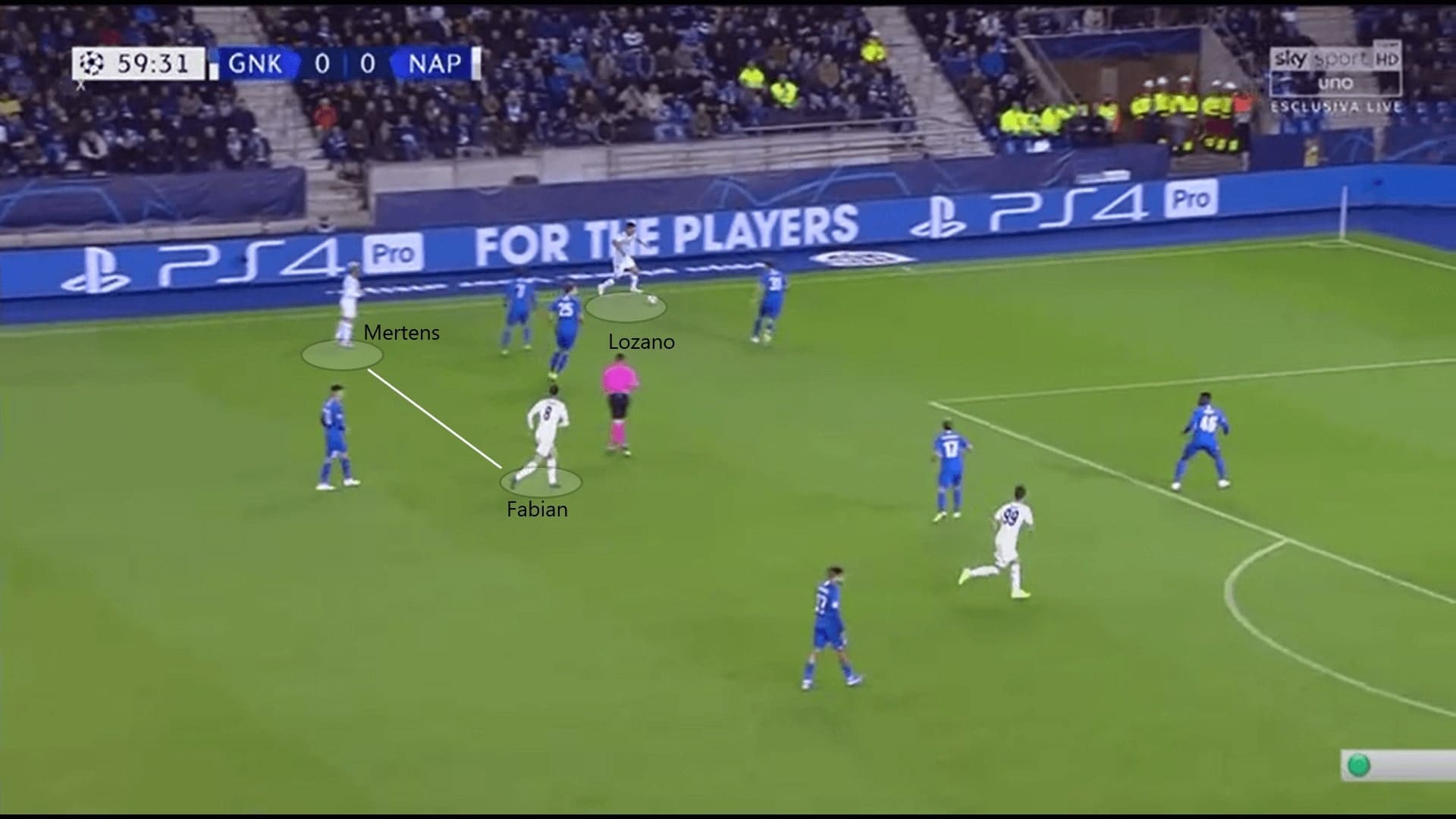
On the right, the situation was also different from the first half. Malcuit, the substitute, stay higher on the pitch to provide the width. All crosses of Malcuit were from the right, after the swap in positions, there were six in total.
The below image as an example. Malcuit joint the attack on the right. Callejón positioned himself in the half-spaces, tried to take away the left-back Uronen again. This generated spaces for the French to exploit, who played a one-two with Callejón, then crossed the ball which resulted in Milik’s header.
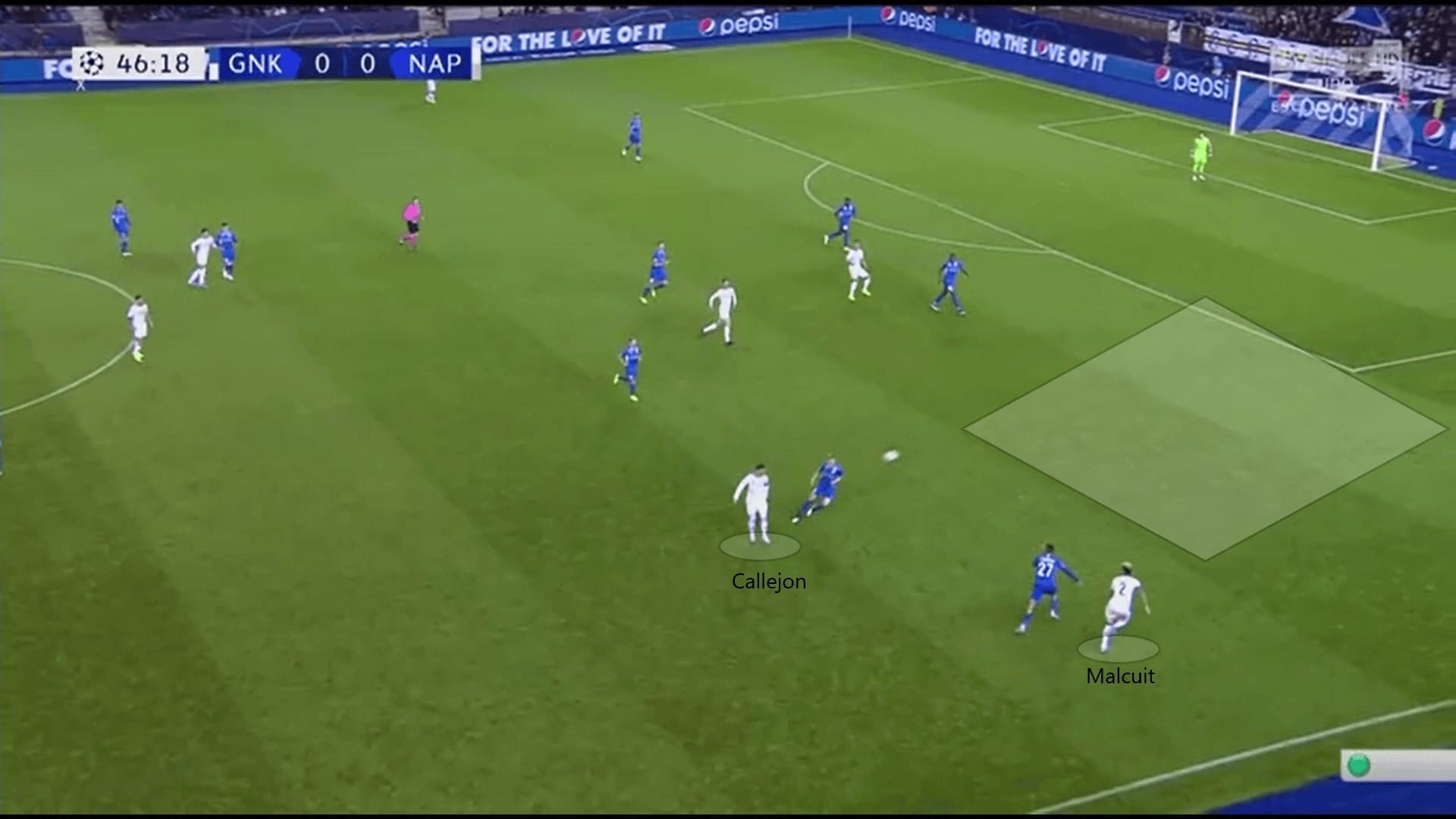
Conclusions
Napoli was the better side of the game. The quality chances created, the way they controlled the game, the way they generated their chances, were well trained and performed. However, they were unlucky, hit the woodworks for a couple of times, and not clinical in front of goal. They created an xG of 3.56 but they wasted their chances. For Genk, they also fought hard to make the game competitive. Despite they were tired in the second half, it was still a good game to watch from a tactical point of view.

If you love tactical analysis, then you’ll love the digital magazines from totalfootballanalysis.com – a guaranteed 100+ pages of pure tactical analysis covering topics from the Premier League, Serie A, La Liga, Bundesliga and many, many more. Buy your copy of the September issue for just ₤4.99 here





Comments